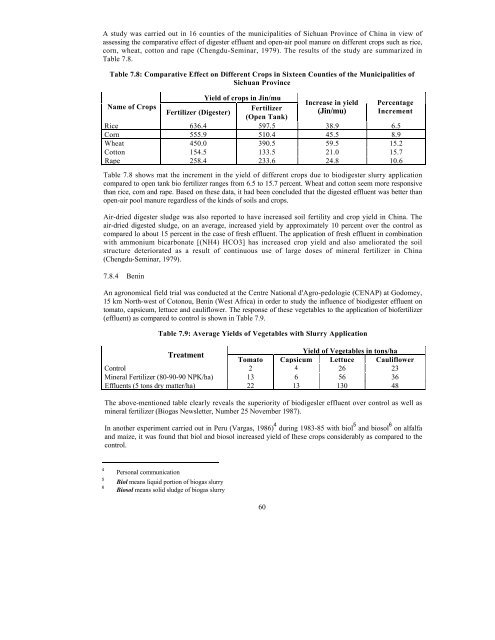download (pdf, 6MB) - SNV
download (pdf, 6MB) - SNV
download (pdf, 6MB) - SNV
You also want an ePaper? Increase the reach of your titles
YUMPU automatically turns print PDFs into web optimized ePapers that Google loves.
A study was carried out in 16 counties of the municipalities of Sichuan Province of China in view of<br />
assessing the comparative effect of digester effluent and open-air pool manure on different crops such as rice,<br />
corn, wheat, cotton and rape (Chengdu-Seminar, 1979). The results of the study are summarized in<br />
Table 7.8.<br />
Table 7.8: Comparative Effect on Different Crops in Sixteen Counties of the Municipalities of<br />
Sichuan Province<br />
Name of Crops<br />
Yield of crops in Jin/mu<br />
Increase in yield Percentage<br />
Fertilizer<br />
Fertilizer (Digester)<br />
(Jin/mu) Increment<br />
(Open Tank)<br />
Rice 636.4 597.5 38.9 6.5<br />
Corn 555.9 510.4 45.5 8.9<br />
Wheat 450.0 390.5 59.5 15.2<br />
Cotton 154.5 133.5 21.0 15.7<br />
Rape 258.4 233.6 24.8 10.6<br />
Table 7.8 shows mat the increment in the yield of different crops due to biodigester slurry application<br />
compared to open tank bio fertilizer ranges from 6.5 to 15.7 percent. Wheat and cotton seem more responsive<br />
than rice, com and rape. Based on these data, it had been concluded that the digested effluent was better than<br />
open-air pool manure regardless of the kinds of soils and crops.<br />
Air-dried digester sludge was also reported to have increased soil fertility and crop yield in China. The<br />
air-dried digested sludge, on an average, increased yield by approximately 10 percent over the control as<br />
compared lo about 15 percent in the case of fresh effluent. The application of fresh effluent in combination<br />
with ammonium bicarbonate [(NH4) HCO3] has increased crop yield and also ameliorated the soil<br />
structure deteriorated as a result of continuous use of large doses of mineral fertilizer in China<br />
(Chengdu-Seminar, 1979).<br />
7.8.4 Benin<br />
An agronomical field trial was conducted at the Centre National d'Agro-pedologie (CENAP) at Godomey,<br />
15 km North-west of Cotonou, Benin (West Africa) in order to study the influence of biodigester effluent on<br />
tomato, capsicum, lettuce and cauliflower. The response of these vegetables to the application of biofertilizer<br />
(effluent) as compared to control is shown in Table 7.9.<br />
Table 7.9: Average Yields of Vegetables with Slurry Application<br />
Yield of Vegetables in tons/ha<br />
Treatment<br />
Tomato Capsicum Lettuce Cauliflower<br />
Control 2 4 26 23<br />
Mineral Fertilizer (80-90-90 NPK/ha) 13 6 56 36<br />
Effluents (5 tons dry matter/ha) 22 13 130 48<br />
The above-mentioned table clearly reveals the superiority of biodigesler effluent over control as well as<br />
mineral fertilizer (Biogas Newsletter, Number 25 November 1987).<br />
In another experiment carried out in Peru (Vargas, 1986) 4 during 1983-85 with biol 5 and biosol 6 on alfalfa<br />
and maize, it was found that biol and biosol increased yield of Ihese crops considerably as compared to the<br />
control.<br />
4<br />
5<br />
6<br />
Personal communication<br />
Biol means liquid portion of biogas slurry<br />
Biosol means solid sludge of biogas slurry<br />
60
















